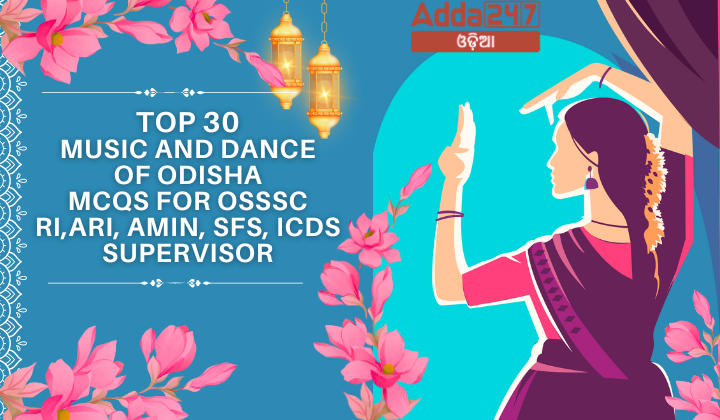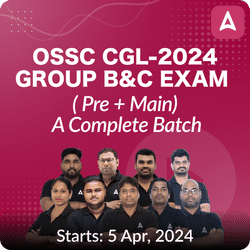Are you preparing for OSSSC RI, ARI, Amin, SFS, ICDS Supervisor exams and seeking to master your knowledge of Odisha’s rich cultural heritage? One integral aspect of Odisha’s culture is its vibrant music and dance forms. To help you ace your exams, here’s a set of multiple-choice questions (MCQs) focusing on the top 30 music and dance forms of Odisha:
Top 30 Music and Dance of Odisha MCQs For OSSSC RI,ARI, Amin, SFS, ICDS Supervisor
- Who is credited with highlighting classical ragas in Odissi music?
A. Jayadeva
B. Kavisurya Baladeva Rath
C. Singhari Shyamasundar Kar
D. Markandeya Mahapatra
Answer: A. Jayadeva - What is the first class of Odissi music, which involves singing the first line or lines repeatedly?
A. Chitrakala
B. Dhruvapada
C. Chitrapada
D. Chhanda
Answer: B. Dhruvapada - Which style in Odissi music involves the arrangement of words in an alliterative manner?
A. Chitrapada
B. Dhruvapada
C. Chitrakala
D. Chhanda
Answer: A. Chitrapada - What represents the originality of Odissi style in Chhandas?
A. Chronological use of letters
B. Occurrence of the same letter or sound at the beginning of adjacent words
C. Combination of bhava, kala, and swara
D. Use of art in music
Answer: B. Occurrence of the same letter or sound at the beginning of adjacent words - Which of the following is NOT a chief Odissi raga?
A. Kalyana
B. Nata
C. Dhanashri
D. Yaman
Answer: D. Yaman - Which of the following is NOT a category of the present musical tradition (Gharanas) of Odisha?
A) Classical Music
B) Traditional Music
C) Light Classical Music
D) Tribal Music
Correct Answer: B) Traditional Music - Which form of Odissi music is considered classical and traditional?
A) Sri Geetagovinda
B) Chhander
C) Chaupadi (Odissi)
D) Ghoda Nacha
Correct Answer: A) Sri Geetagovinda - Which type of music in Odisha is an expression of the ethos and moves of the folk people?
A) Classical Music
B) Light Classical Music
C) Folk Music
D) Tribal Music
Correct Answer: C) Folk Music - Which musical instrument is indigenous to Odisha and is played during festivals such as Baunsa Taranga and Katha Taranga?
A) Khanjani
B) Dholki
C) Madala
D) Ghumura
Correct Answer: D) Ghumura - Which of the following is NOT a stringed musical instrument used in Odisha?
A) Veena
B) Ektara
C) Behela
D) Ghanta
Correct Answer: D) Ghanta - Which traditional instrument of Odisha consists of animal skin stretched over a wooden base and is played during marriage processions?
A) Mahuri
B) Gochi Baja
C) Tamak
D) Kendera
Correct Answer: C) Tamak - What is the traditional wind instrument of Odisha that is played during marriages and folk theatres like Rama Nataka?
A) Gochi Baja
B) Kendera
C) Mahuri
D) Ghanta
Correct Answer: C) Mahuri - Which percussion instrument, considered auspicious, is typically played in marriage processions in Odisha?
A) Kendera
B) Ghanta
C) Gochi Baja
D) Mahuri
Correct Answer: C) Gochi Baja - Which ethnic stringed instrument is ritually used by ascetics of the Nâtha sect while gathering alms in Odisha?
A) Kendera
B) Tamak
C) Ghanta
D) Gochi Baja
Correct Answer: A) Kendera - During which festival in Puri, Odisha, is the metallic gong known as Ghanta used as a percussion instrument?
A) Durga Puja
B) Diwali
C) Ratha Jatra
D) Holi
Correct Answer: C) Ratha Jatra - What is the origin of Odissi dance?
A) Temples of Odisha
B) Royal courts of Odisha
C) Tribal communities of Odisha
D) Buddhist monasteries of Odisha
Answer: A) Temples of Odisha - When did Odissi dance receive recognition as a classical dance form?
A) 1947
B) 1958
C) 1965
D) 1972
Answer: B) 1958 - Who is considered as the replica of Lord Jagannath’s body position in Odissi dance?
A) Guru Kelucharan Mohapatra
B) Guru Pankaj Charan Das
C) Lord Krishna
D) The dancer in chowka position
Answer: D) The dancer in chowka position - Which elements are included in Odissi dance?
A) Tandava and Manipuri
B) Lasya and Kathak
C) Tandava and Lasya
D) Kathak and Bharatanatyam
Answer: C) Tandava and Lasya - Who are some renowned Odissi dancers?
A) Sonal Mansingh and Indrani Rahman
B) Guru Kelucharan Mohapatra and Kumkum Mohanty
C) Guru Pankaj Charan Das and Ileana Citaristi
D) All of the above
Answer: D) All of the above - What is the historical significance of Odissi dance?
a) Originated during the Mughal era
b) Emerged during the British colonial period
c) Traced back to the Gauya rulers of Utkala
d) Invented by Ananabhimadeva
Answer: c) Traced back to the Gauya rulers of Utkala - Who were the Maharis in Odissi dance tradition?
a) Male temple dancers
b) Devotees of Lord Jagannath
c) Temple dancers or devadasis of the Jagannath temple
d) Royal court dancers of Odisha
Answer: c) Temple dancers or devadasis of the Jagannath temple - Which age group typically performs Gotipua dance?
a) Adult males
b) Girls below 14 years
c) Elderly women
d) Boys below 14 years
Answer: d) Boys below 14 years - Where is Raghurajpur village located, known for its Gotipua dance?
a) Puri district
b) Bhubaneswar city
c) Cuttack district
d) Ganjam district
Answer: a) Puri district - What is the thematic focus of Gotipua dance performances?
a) Contemporary social issues
b) Political satire
c) Mythology and Puranic literatures
d) Romantic love stories
Answer: c) Mythology and Puranic literatures - What community primarily practices the Jhoomar Dance?
A) Mahanta and Munda communities
B) Paika community
C) Odia warriors
D) Tribal communities of Odisha
Answer: A) Mahanta and Munda communities - Which dance form is associated with the Paika, the warrior class of the old Odia army?
A) Jhoomar Dance
B) Paika Dance
C) Chhau Dance
D) Gotipua Dance
Answer: B) Paika Dance - Where is the Paika Akhada, a place for practicing Paika Dance, commonly found?
A) Sundargarh
B) Khurda
C) Mayurbhanj
D) Balasore
Answer: B) Khurda - Which deity do Chhau dancers primarily worship?
A) Lord Vishnu
B) Goddess Durga
C) Lord Shiva and Goddess Parvati
D) Lord Krishna
Answer: C) Lord Shiva and Goddess Parvati - Which districts of Odisha are known for the performance of Chhau Dance?
A) Sundargarh, Balasore, Jharsuguda, and Mayurbhanj
B) Khurda, Puri, Cuttack, and Dhenkanal
C) Balasore, Dhenkanal, Keonjhar, and Mayurbhanj
D) Gajapati and Nayagarh
Answer: C) Balasore, Dhenkanal, Keonjhar, and Mayurbhanj
















